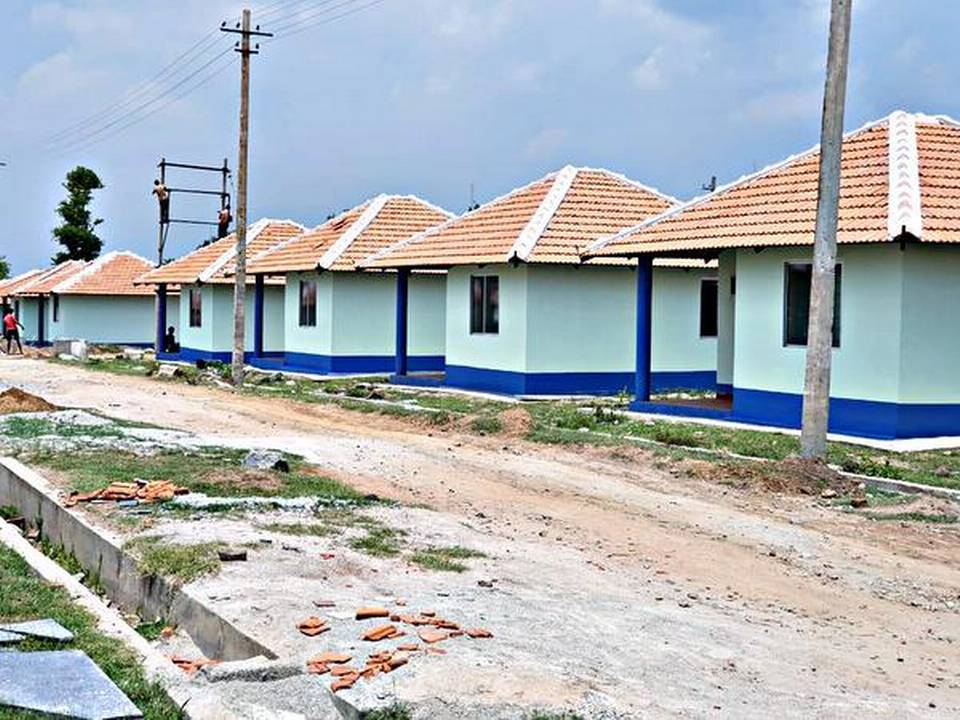
Each house has been built on a 30×40 sq. ft plot at a cost of ₹4.70 lakh; total cost of the project is ₹39.27 crore
Residential colonies coming up in Kodagu for displaced tribals of Diddahalli forests are being developed as ‘model settlements’, putting across facilities usually found in layouts developed in cities, such as well-laid roads, piped water supply, and CCTV surveillance.
The tribals relocated from Diddahalli forests in Virajpet taluk in the district have been provided shelter in the newly-constructed settlements at Basavanahalli and Byadagotta villages in Somawarpet taluk, with the State government coming forward to build individual houses for the families. Each house has been built on 30×40 sq.ft. plot and the project is nearing completion with only a few houses remaining to be built besides establishing essential facilities.
Out of 528 houses proposed for construction, 338 houses had been completed and some families have already shifted to their new dwelling. The construction began two years ago, according to C. Shivakumar, Project Coordinator, Integrated Tribal Development Project (ITDP).
Kodagu Nirmithi Kendra has built each house at a cost of ₹4.70 lakh. The total cost of the project is ₹39.27 crore. So far, ₹21.76 crore had been released to the Nirmithi Kendra for having completed the construction of 338 houses, he told The Hindu.
The Nirmithi Kendra has taken up works like the installation of water tanks for each house, laying of pipelines, covering drainages with stone slabs, construction of parks and fencing, and installation of surveillance cameras at a cost of ₹2.72 crore.
At both Basavanahalli and Byadagotta, a sum of ₹8 crore was being spent on construction of roads, drainages, septic tanks, UGD lines, culverts, overhead tank, and anganwadi kendras besides establishing electricity connection and water distribution lines to every house.
Out of 174 houses in Basavanahalli, 138 houses had been completed. Byadagotta will have about 354 houses. There are about 84 temporary dwellings which will be making way for the construction of permanent houses consisting of a living room, a bedroom, kitchen, bathroom and other facilities.
Survey identifies 3,000 tribal families
A joint survey by the authorities of various departments in Kodagu has identified around 3,000 tribal families, mostly Yeravas and Jenukurubas, living in various plantations in the district.
The survey was done to collate information on the number of tribal families living outside the forests and working in plantations, which are in need of dwelling.
The survey was done by a committee comprising representatives from the Departments of Revenue, Police, Labour, Tribal Welfare and Public Instruction.
Children admitted to residential schools
Away from the accustomed schooling in government-run ashram schools, tribal children in Kodagu have an opportunity to pursue an education in government-run residential schools – Morarji Desai Residential School and Jawahar Navodaya Vidyalaya.
The authorities of Integrated Tribal Development Project (ITDP) persuaded the tribal families in the district and their children appeared for the entrance examination to these schools.
As many as 53 tribal children have been selected for Morarji Desai Schools in Madikeri, Somwarpet and Virajpet areas. Two children from tribal settlements have made it to the Jawahar Navodaya Vidyalaya in Madikeri.
“This is perhaps the first time that tribal children from the areas wrote the entrance examination and a few of them got selected. Now the challenge is to persuade their parents to complete the admission process since many are reluctant to send their wards to schools outside their settlement,” said C. Shivakumar, Project Coordinator, ITDP.
Most of the children selected for the residential schools belong to the primitive tribes. There are 11 ashram schools in the district.
source: http://www.thehindu.com / The Hindu / Home> News> States> Karnataka / by Special Correspondent / Mysuru – June 02nd, 2019

